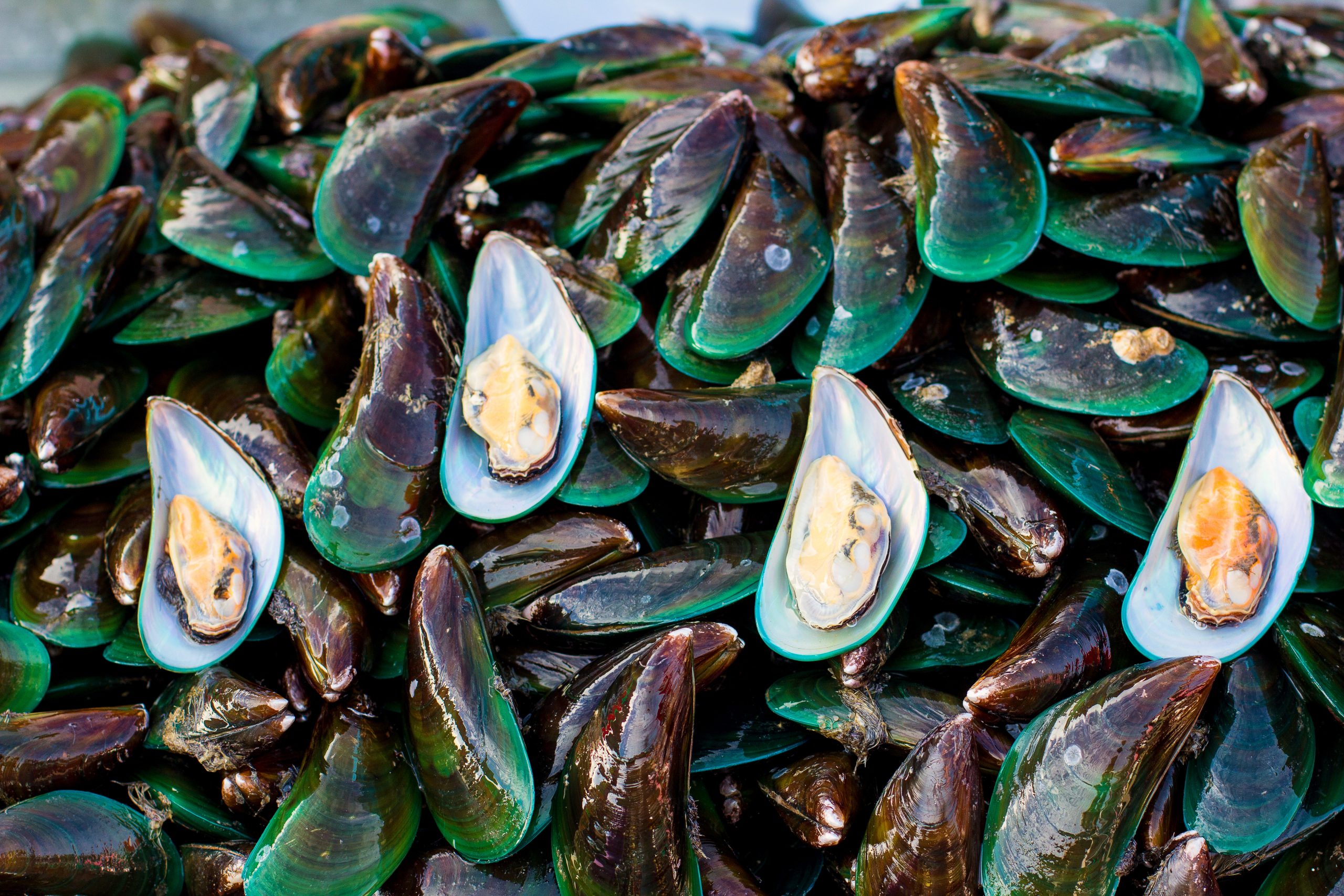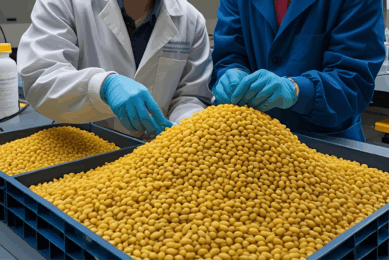Proteins for pigs derived from the sea

In the search for alternative protein sources, it may be a very good idea to look towards the sea for inspiration. What are the opportunities for ingredients like blue mussels, starfish and seaweed? Here’s an overview.
Everybody agrees that it is likely that someday, there will be a shortage of protein to feed livestock in order to fulfil the expected big increase in the demand for meat for human consumption. In Europe, there is also a general agreement that land for agriculture at the expense of the rainforest in South America is not the way forward to produce soy protein to feed livestock. A prevailing opinion is also that fish caught with the only purpose of going into feed is not a sustainable way to produce meat.
These issues create a need to search for new sustainable protein sources, which can lead to local or at least European self-sufficiency. As from the beginning of 2018, the organic pig and poultry producers will face a challenge of having sufficient amounts of organic protein. In this context, blue protein, such as blue mussels, starfish, and seaweed may fit well as future feedstuffs, because they solve important challenges for the industry and society.
Mussels
Blue mussels can be grown on lines where the naturally occurring mussel larvae colonise ropes or plastic tubes or nets as of late spring. They filter the seawater for algae and can be harvested year round and already from the first coming winter, preferably before the risk of ice coverage. When mussels are harvested, they need to be processed to allow storage.
Using mussels to remove N and P from sea water
The production of mussel meal in the Danish fjords is potentially 15,000 tonnes of de-shelled dry mussel meal per year. Placement of mussel farms should be in nutrient-rich water of a quality, which is good enough to meet the EU regulations for mussel farming. An experiment in a Danish inland fjord using a mussel farm on 18 ha showed an annual production of 61 tonnes fresh mussels per hectare. The harvest of these mussels removed 600-900kg nitrogen (N) and 30‑40kg phosphorus (P) per hectare of mussel farm. When mussels are cultivated with the purpose to remove especially N and P from sea water, they are termed mitigation mussels, and are expected to play a major role in reducing eutrophication problems.
Mussel meal
Mussel meal is characterised by a crude protein content of 58-66% in dry matter, a low mineral concentration, and for pigs and poultry, a balanced amino acid profile. The crude fat content of 12-16% in dry matter includes a relatively large amount of poly unsaturated fatty acids and especially the omega-3 fatty acids eicosapentaenoic (EPA) and docosahexaenoic (DHA). An overview of the nutrient content of the blue biomasses is presented in Table 1. Mussels also contain carotenoids, such as β-caroten, lutein A, zeaxanthin, and xanthofyls like astaxanthin. The ileal digestibility of crude protein in pigs is 0.83.
Starfish
The use of starfish for livestock is not new. During the shortage of feedstuffs during and after World War II starfish was included in feed for livestock and a few experiments were carried out to document the effect in especially poultry. In the Danish fjords, starfish was caught as feedstuff until mid-1980s when the problems with TSE (transmissible spongiform encephalopathies) and the following restrictions of feeding fish to ruminants forced the fishing of starfish to cease.
Starfish a problem for the mussel industry
Starfish are feeding on mussels, and this became a problem for the mussel industry, who found great populations of starfish. In 2013 the Danish authorities approved starfish being caught in certain areas with production of mussels in amounts corresponding to 3,000 tonnes of dry starfish meal per year. At that time, starfish could only be fed in aquaculture.
Challenges for starfish meal use
As from July 2017, starfish has been approved in the EU as a feed ingredient in diets for pigs and poultry. Starfish meal is categorised in a group along with fish. This is unfortunate because of restrictions in the TSE legislation, making it difficult for the feed industry to handle starfish meal because it cannot be stored and handled in facilities with a connection to feed for ruminants, although starfish are invertebrates and thus safe products. Starfish are characterised by a crude protein concentration in the range of 38-70% and a ash concentration of 20-42% in dry matter depending on season. The highest concentration of crude protein and the lowest concentration of ash is found in February. The ash is not sand but a high concentration of calcium. The concentration of fat is 9-11% in dry matter and poly unsaturated fatty acids are found. The standardized ileal digestibility of crude protein in starfish meal is 0.80.
2 growth performance experiments have been conducted on starfish for pigs:
- The first showed that 5% but not 10% starfish meal could be fed to piglets, which were individually housed under experimental conditions
- The second experiment confirmed that 5% but not 7.5% starfish meal could be fed to piglets housed under commercial conditions.
Seaweed
Asia produces 99% of the 25 million tonnes of fresh seaweed, which is produced annually worldwide. In Europe, the greatest production is in Norway and France. European seaweed is often collected manually from natural habitats but can also be cultivated on farms by a rope-based facility, requiring a lot of work and labour.
Environmental conditions determine seaweed’s annual production levels
The use of seaweed is primarily for human consumption, either as intact seaweed or as extracts. The potential of seaweed production is very dependent on the quality of sea water, which should have high salinity, low temperature, and low nutrient concentration to allow clear water for sunlight. These environmental conditions determines the annual production in the range from 3 to 30 tonnes fresh weight per ha of seaweed farm.
Nutritional value varies with species
The concentration of nutrients varies according to species. Sugar kelp and sea lettuce are considered to have the greatest production potential in Danish waters.
- Sugar kelp is a brown algae which is characterised to contain 14-38% ash in dry matter and a crude protein concentration of 7-13% in dry matter. The concentration of sodium, potassium and iodine is high.
- Sea lettuce is a green algae with typically more than 15% crude protein and an amino acid profile close to that of soy bean meal. It has high concentrations of sulphur, calcium, magnesium, sodium, and chloride.
Based on these key figures of nutrient content, it’s obvious that seaweed in general can barely be termed as protein sources. The content of the alginates, fucoidans and laminarins, and polyphenols in brown algae and the galactans and xylans in green algae displays some interesting bioactive properties, which can be utilised in maintaining good health status in livestock. It is therefore of great importance that the bioactive compounds are taken into account when processing seaweed into their final products.

Processing into feedstuffs
Mussels, starfish and seaweed needs to be processed before they can be stored. Production into dry meal is a well-known preserving method, but also making the products into acidic silage may be interesting. There are, however, great challenges. Starfish and seaweed are fairly simple to dry when using existing industrial technologies. Drying and grinding starfish at a fishmeal factory is a well-known process to produce starfish meal. The blue mussels are more difficult to handle because of the shells. When used for pig feed, the meat should be separated from the shell fraction, but there may be a potential use of a shell-containing mussel product for poultry.
Removal of shells can efficiently be done by boiling, which is a well-known process with mussels for human consumption. In the boiling process, there is risk of losing both protein and lipids. Other processing methods to remove shells can be based on physical separation by e.g. sedimentation of crushed fresh mussels or screw pressing of the fresh mussels, enzymatic processes, or by dry fractionation. In Sweden, work on processing blue mussels into meal has resulted in a patent on separation of meat and shells by a temperature mediated hydrolysis.
Not drying, but presenting it wet
An alternative to a dry mussel meal product can be a wet silage product stabilised by organic acids, also known from salmon-based products.
- Experiences from drying starfish shows that the product is sensitive to temperature and the starfish meal becomes very dark at too high temperatures indicating Maillard reactions, in which especially lysine becomes unavailable to the animal.
- Addition of organic acids to the fresh and minced mussels and a following stirring process results in a silage with a partial hydrolysis of the protein fraction into free amino acids and peptides. This has in blue mussels increased the standardised ileal digestibility of crude protein to 0.86 in mussel silage compared to 0.83 in mussel meal.
- Starfish are not suitable for acid hydrolysis because of their high content of calcium carbonate. Making silage by lactic acid bacteria fermentation may result in positive effects on the composition of gut microbiota.
- Seaweed is relatively easy to ferment because of its high concentration of carbohydrates. The fermentation of intact sugar kelp into pig feed, has been commercialised by the Danish company Fermentation Experts.
- Starfish are easy to handle at fish meal factories, but it may be difficult to process starfish at such facilities because of low tonnage and a fishing season overlapping with the traditional fishery. Therefore, alternative processing methods may be relevant. It appears, however, that the physical characteristics of starfish makes them difficult to handle, when they are minced using a screw press, which would otherwise produce a protein rich liquid fraction for use in e.g. liquid pig feeding and a dry pulp fraction to be used as e.g. fertiliser.
References available on request.
This article is a summary of a presentation that was given at Victam 2017, in Cologne, Germany.

Find out more about some of the protein alternatives for soy that are currently seen as promising for livestock and fish diets.
Author: Jan V. Nørgaard, Associate Professor, Aarhus University, Denmark











